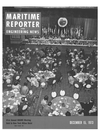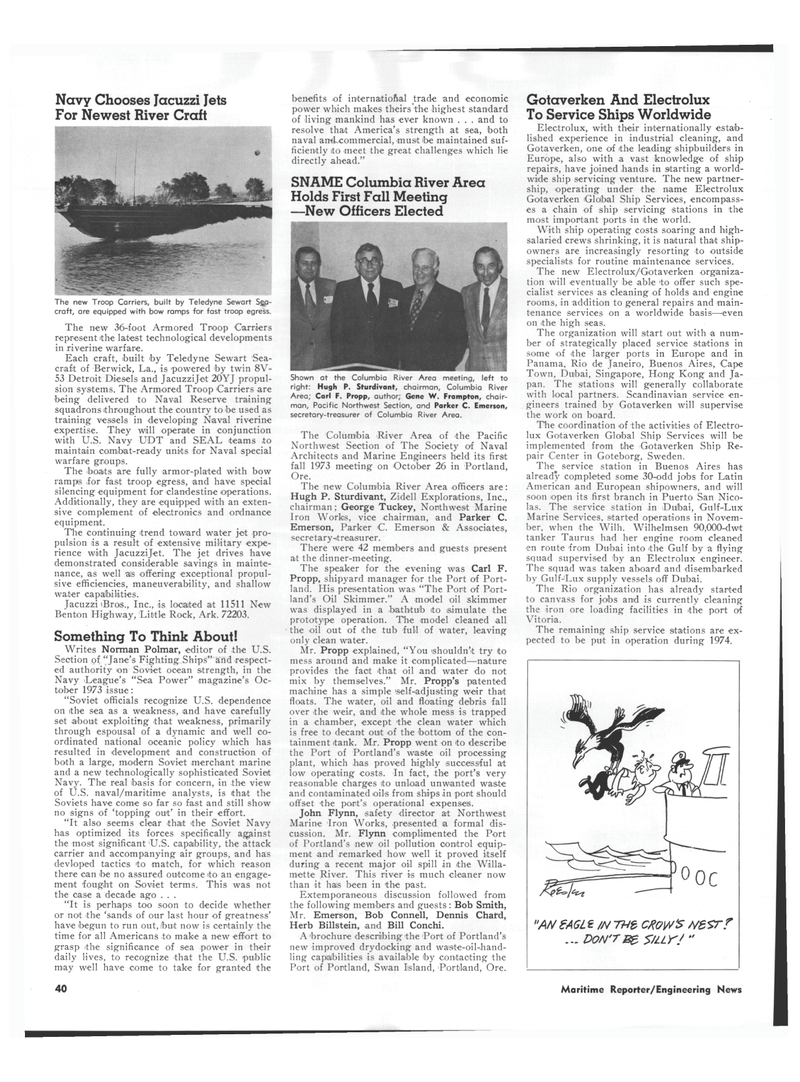
Page 38: of Maritime Reporter Magazine (December 15, 1973)
Read this page in Pdf, Flash or Html5 edition of December 15, 1973 Maritime Reporter Magazine
Navy Chooses Jacuzzi Jets
For Newest River Craft
The new Troop Carriers, built by Teledyne Sewart Sgp- craft, are equipped with bow ramps for fast troop egress.
The new 36-foot Armored Troop Carriers represent ithe latest technological developments in riverine warfare.
Each craft, built 'by Teledyne Sewart Sea- craft of Berwick, La., is powered by twin 8V- 53 Detroit Diesels and JacuzziJet 20YJ propul- sion systems. The Armored Troop Carriers are being delivered to Naval Reserve training squadrons throughout the country to be used as training vessels in developing Naval riverine expertise. They will operate in conjunction with U.S. Navy UDT and SEAL teams ,to maintain combat-ready units for Naval special warfare groups.
The boats are fully armor-plated with bow ramps ,for fast troop egress, and have special silencing equipment for clandestine operations.
Additionally, they are equipped with an exten- sive complement of electronics and ordnance equipment.
The continuing trend toward water jet pro- pulsion is a result of extensive military expe- rience with JacuzziJet. The jet drives have demonstrated considerable savings in mainte- nance, as well ais offering exceptional propul- sive efficiencies, maneuverability, and shallow water capabilities.
Jacuzzi iBros., Inc., is located at 11511 New
Benton Highway, Little Rock, Ark. 72203.
Something To Think About!
Writes Norman Polmar, editor of the U.S.
Section of "Jane's Fighting Ships" and respect- ed authority on Soviet ocean strength, in the
Navy League's "Sea Power" magazine's Oc- tober 1973 issue: "Soviet officials recognize U.S. dependence on the sea as a weakness, and have carefully set about exploiting that weakness, primarily through espousal of a dynamic and well co- ordinated national oceanic policy which has resulted in development and construction of both a large, modern Soviet merchant marine and a new technologically sophisticated Soviet
Navy. The real basis for concern, in the view of U.S. naval/maritime analysts, is that the
Soviets have come so far so fast and still show no signs of 'topping out' in their effort. "It also seems clear that the Soviet Navy has optimized its forces specifically against the most significant 'U.S. capability, the attack carrier and accompanying air groups, and has devloped tactics 'to match, for which reason there can be no assured outcome to an engage- ment fought on Soviet terms. This was not the case a decade ago . . . "It is perhaps too soon to decide whether or not the 'sands of our last hour of greatness' have 'begun to run out,/but now is certainly the time for all Americans to make a new effort to grasp the significance of sea power in their daily lives, to recognize that the U.S. public may well have come to take for granted the benefits of internatiofial trade and economic power which makes theirs the highest standard of living mankind has ever known . . . and to resolve that America's strength at sea, both naval arreLcommercial, must be maintained suf- ficiently to meet the great challenges which lie directly ahead."
SNAME Columbia River Area
Holds First Fall Meeting —New Officers Elected
Shown at the Columbia River Area meeting, left to right: Hugh P. Sturdivant, chairman, Columbia River
Area; Carl F. Propp, author; Gene W. Frampton, chair- man, Pacific Northwest Section, and Parker C. Emerson, secretary-treasurer of Columbia River Area.
The Columbia River Area of the Pacific
Northwest Section of The Society of Naval
Architects and Marine Engineers held its first fall 1973 meeting on October 26 in Portland,
Ore.
The new Columbia River Area officers are:
Hugh P. Sturdivant, Zidell Explorations, Inc., chairman; George Tuckey, Northwest Marine
Iron Works, vice chairman, and Parker C.
Emerson, Parker C. Emerson & Associates, secretary-treasurer.
There were 42 members and guests present at the dinner-meeting.
The speaker for the evening was Carl F.
Propp, shipyard manager for the Port of Port- land. His presentation was "The Port of Port- land's Oil Skimmer." A model oil skimmer was displayed in a .bathtub to simulate the prototype operation. The 'model cleaned all • the oil out of the tub full of water, leaving only clean water.
Mr. Propp explained, "You 'shouldn't try to mess around and make it complicated—nature provides the fact that oil and water do not mix by themselves." Mr. Propp's patented machine has a simple 'self-adjusting weir that floats. The waiter, oil and floating debris fall over the weir, and the whole mess is trapped in a chamber, except the clean water which is free to decant out of the bottom of the con- tainment tank. Mr. Propp went on to describe the Port of Portland's waste oil processing plant, which has proved highly successful at low operating costs. In fact, the port's very reasonable charges to unload unwanted waste and contaminated oils from ships in port should offset the part's operational expenses.
John Flynn, safety director at Northwest
Marine Iron Works, presented a formal dis- cussion. Mr. Flynn complimented the Port of Portland's new oil pollution control equip- ment and remarked how well it proved itself during a recent major oil spill in the Willa- mette River. This river is much cleaner now than it has been in the past.
Extemporaneous discussion followed from the following members and guests: Bob Smith,
Mr. Emerson, Bob Connell, Dennis Chafd,
Herb Billstein, and Bill Conchi.
A'brochure describing the Port of Portland's new improved drydocking and waste-oil-hand- ling capabilities is available by contacting the
Port of Portland, Swan Island, Portland, Ore.
Gotaverken And Electrolux
To Service Ships Worldwide
Electrolux, with their internationally estab- lished experience in industrial cleaning, and
Gotaverken, one of the leading shipbuilders in
Europe, also with a vast knowledge of ship repairs, have joined hands in starting a world- wide ship servicing venture. The new partner- ship, operating under the name Electrolux
Gotaverken Global Ship Services, encompass- es a chain of ship servicing stations in the most important ports in the world.
With ship operating costs soaring and high- salaried crews shrinking, it is natural that ship- owners are increasingly resorting to outside specialists for routine maintenance services.
The new Electrolux/Gotaverken organiza- tion will eventually be able to offer such spe- cialist services as cleaning of holds and engine rooms, in addition to general repairs and main- tenance services on a worldwide basis—even on the high seas.
The organization will start out with a num- ber of strategically placed service stations in some of the larger ports in Europe and in
Panama, Rio de Janeiro, Buenos Aires, Cape
Town, Dubai, Singapore, Hong Kong and Ja- pan. The stations will generally collaborate with local partners. Scandinavian service en- gineers trained by Gotaverken will supervise the work on board.
The coordination of the activities of Electro- lux Gotaverken Global Ship Services will be implemented from the Gotaverken Ship Re- pair Center in Goteborg, Sweden.
The service station in Buenos Aires has already completed some 30-odd jobs for Latin
American and European shipowners, and will soon open its first branch in Puerto San Nico- las. The service station in Dubai, Gulf-Lux
Marine Services, started operations in Novem- ber, when the Wilh. Wilhelmsen 90,000-dwt tanker Taurus had her engine room cleaned en route 'from Dubai into the Gulf by a flying squad supervised by an Electrolux engineer.
The squad was taken aboard and disembarked by Gulf-Lux supply vessels off Dubai.
The Rio organization has already started to canvass for jobs and is currently cleaning the iron ore loading facilities in the port of
Vitoria.
The remaining ship service stations are ex- pected to be put in operation during 1974. "AN €AGL € /N TUt CROW'S NSST? ... DON'TS/Ltr.' " 40 Maritime Reporter/Engineering News

 37
37

 39
39
